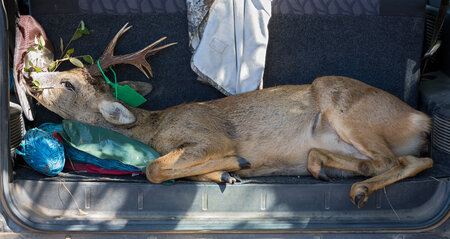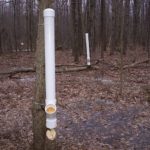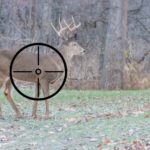Not every hunter has a pickup truck. But while your friends might say otherwise, you don’t necessarily need one for deer hunting.
You can fit a deer in a car or SUV, no truck required. Weighing around 150 lbs, an average field-dressed deer can fit in the trunk of most passenger cars. You can also strap a deer to your roof (or trunk), haul it behind your car, or quarter it for transport in containers (if that’s legal in your state).
Besides leaning on my own experience, I spent a lot of time studying hundreds of hunting forums and Reddit posts that go back more than a decade. Consider what follows in this article to be advice from a collection of practical car hunters who didn’t unnecessarily waste a load of cash on a truck.
So how do you transport a deer without a truck?
With a little creativity and organization, you can be ready to bring home that buck in a Honda Civic!
How to Put a Deer in the Trunk of Your Small Car
The preparation starts before you even leave your house. Start by cleaning all the useless junk out of your trunk so you have room for a deer if you get one.
If you don’t need something for the hunt (or maybe an emergency), then leave it at home.
Next, gather supplies for transporting a deer after your hunt. At minimum, you will need some items you probably already have in the garage.
Here is a list of some recommended supplies for transporting a deer in the trunk of your car:
- Medium sized tarp
- Old newspapers, cardboard, or carpet scraps
- Tie-down straps
- Rope or some nylon paracord
- Old sheet or a game bag
Line Your Trunk
The goal of lining your trunk is two fold: (1) to keep the stink from taking over your car, and (2) to keep your venison edible.
If you are feeling optimistic, this part could be done even before you leave for the hunt. You could have your trunk lined and ready to go for a quick return once you fill your tag.
The tarp acts as a liner for your trunk so you don’t get blood and stench all over your car. It will also help the deer stay clean so as not to taint the meat with whatever could be collecting in your trunk upholstery. In addition, the tarp can help contain any ticks or insects that come off the deer, so you can get them out of your car after the hunt.
Take some old newspapers or cardboard to put on the floor of your trunk under the tarp. This helps to absorb any blood that might leak from the carcass and can help avoid a foul smell lingering after the hunt. A carpet scrap or an old rug laid down can help do the same thing, perhaps more than once if washed between uses.
Once the underlayment is in place, place the middle of the tarp in the middle of the trunk, and line the whole trunk with the sides of the tarp folded up like a tortilla bowl. A little excess tarp at the top doesn’t hurt. You may need it.
If you have an SUV or wagon, use some duct tape to secure the tarp up above the windows. This will help keep deer blood and grime off the sides when loading and unloading your deer.
Consider Scotchgard
If you plan to use your car to transport deer more than once, it might be worth treating the upholstery of your entire trunk with some Scotchgard protectant. You may even be able to find a local car detailing company who can do this for you as a service with commercial grade products.
Even with Scotchgard, I’d still be putting down a tarp or something to avoid the mess. But the price is probably worth it to some for added reassurance.
Prepare to Load a Deer into the Trunk of Your Car or SUV
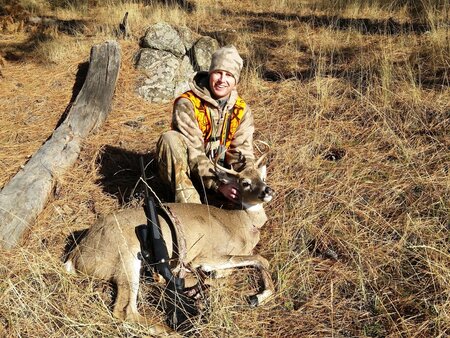
Now that you have successfully shot, tracked, and photographed our deer, you need to load it into your trunk.
Unless you have a really good reason not to, field dress your deer. Gut it and place it on an incline to drain as much of the blood as possible so it doesn’t end up in your car. You may even rotate it a couple times so all the open cavities have a turn to face downhill and drain.
Related: How Long After Shooting a Deer Do You Have to Gut It?
If you skin your deer in the field, go for it. Removing the hide as early as possible is best if you’re going to tan the deer hide. It can also help shed a bit more weight and keep some of the nasty ticks and insects out of your car.
I prefer to gut the deer where I shoot it, drag it to my car with skin on, then skin it where I’m parked. This makes it easier to drag and keeps the meat cleaner.
It is best to cut the lower legs off at this point as well. This will reduce the length of awkward appendages you are going to try and fold into the trunk. The coyotes will thank you!
Once back at your car, prepare your car by putting all your gear in the front or rear passenger seats so the trunk has room for the deer.
Most cars allow you to fold the rear seats down forward as well, but only do this if you need the extra space for the deer. Otherwise you’re spreading the nasty aroma needlessly. If you do fold the seats down, be sure and spread the tarp out enough to cover up the exposed upholstery and carpet.
Now you need to get the deer into the trunk.
How to Load a Deer into Your Trunk
Ideally, you have a hunting partner who can help you hoist the deer into the trunk. Bend your knees, keep your back straight, and all that good stuff. Grasp the deer by the legs and heave it into the trunk.
You could also use a portable game elevator to easily lift the deer into your car, but then you’ll need space in the car for the gadget as well.
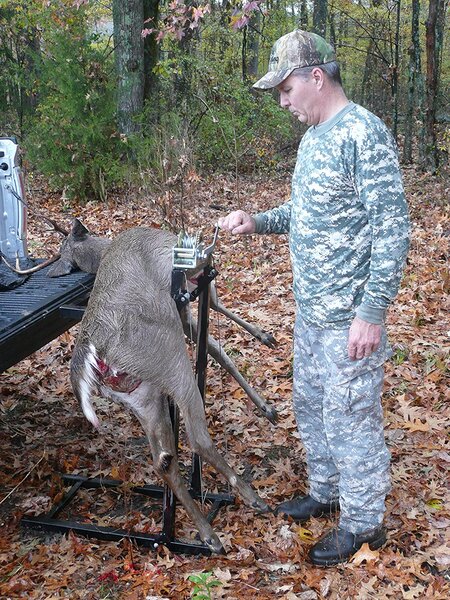
Without a fancy gadget you can try to back your car up perpendicular to the base of a slope or into a low spot. A roadside ditch that isn’t too deep with a steep cut slope, or a berm could work. Maybe even get the deer onto a big boulder first and back up to that.
The car will need to be basically touching the slope or boulder. The idea is to get the deer higher than the car so you can easily lower the deer into the trunk.
You could also suspend the deer from a tree with a rope, pulley it up so it’s hanging, then back the car up just below it. Gently lower the deer into the trunk and voilà!
Be sure and position the deer’s head to the right side of the car. If the deer cannot fit entirely in the trunk so you can close the hatch, you will want to hang its head to the right side of the car. This will help avoid hitting oncoming traffic and make it easier to drive carefully. Just watch out for sign posts and guard rails!
Strap Down the Trunk Hatch
Unless you drive a Crown Vic, there is a good chance you will not be able to entirely close the hatch. That’s okay. You’ll just need something to tie down your trunk and/or deer. This is where the tie-down straps come in.
I recommend the ratchet kind with smaller hooks or basic lashing straps that cinch down because they are usually longer and they give you a loose end to easily feed through little gaps. This is probably necessary to find an attachment point on a car that doesn’t have big D-rings or eye hooks built in everywhere.
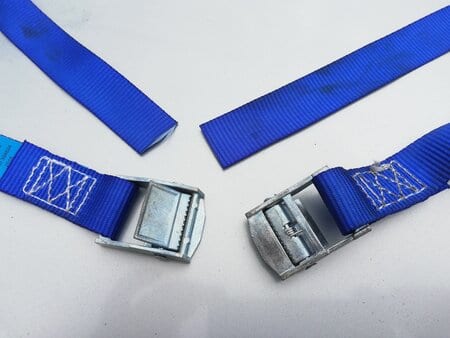
Avoid the motorcycle tie downs with the heavy-duty “S” hooks or real thick straps. You probably don’t have many places to attach the S-hook and if so, they might beat against the body of your car and dent or scratch it. Thick straps aren’t necessary since the load is relatively light and they’d be harder to feed through small gaps.
Rope or some nylon paracord could be handy as a backup to the tie-down straps. It may also help bind up the deer to make it fit.
Run a strap through the latch hook for the trunk or around the hinge arms of the trunk. You can even run the straps under or around the deer itself. The strap should then run around the top of the trunk and back inside to ensure the trunk lid won’t bounce up and down too much, potentially damaging your trunk.
You may spend more or less time securing the load depending on the weather or how far you have to go.
How to Keep Deer Meat from Spoiling During Transport
It’s crucial to allow the deer carcass to have air flow during transport as much as possible in order to prevent the meat from spoiling.
When you load a deer in your car, be sure to avoid sealing it in plastic garbage bags. This will trap in heat and moisture, creating a bacteria breeding ground.
I skin my deer in the field. I find it easier when it’s still warm and it helps cool the meat faster, which matters to me since I often have a long drive home.
Wrapping a skinned deer in porous cloth material allows the meat to cool and breathe while keeping the bugs and dirt off. During transport, it helps wick moisture and avoid bacteria buildup which can spoil the meat.
I keep an old bed sheet with my hunting gear that I like to use to wrap my skinned deer in for transport. I just wash it after each hunt so I can use it again next year.
A big game bag could work as well, but I prefer not to spend money on something that’s disposable when I have something that already does the trick.
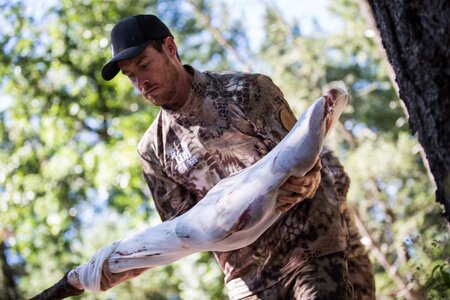
If you don’t skin your deer in the field, you can probably skip the sheet.
If the air is below 40°F, let the carcass cool as much as possible before putting it in your trunk. Consider propping the body cavity open with sticks to allow more air circulation inside.
If it is warmer weather, you might stop and pick up some ice. Put it in plastic bags and set them inside the open cavity to assist with cooling.
You should avoid putting a deer on the roof of the car in warm weather.
Once the deer is in your trunk, don’t leave it in there unattended for long, especially on a warm day. Get it home or to the butcher where it can be hung in a cool place.
Source: PennState Extension
In Which Cars Can You Fit a Deer?
Clearly deer vary in size by species, age, sex, and environment just like cars vary in size by make and model.
A young Whitetail doe can likely fit in a small hatchback while a big old Mule Deer buck might require a 1980’s Cadillac to fit entirely in the trunk.
Generally speaking, Whitetail hunters will fit a deer into just about any passenger car from a compact to a full-size sedan. The trunk may fully close or you may need to leave the hatch cracked open and strapped down as described above.
Mule deer hunters may need a full size sedan like a Toyota Camry to make it work with a big buck.
Related: What’s a Good Hunting Vehicle That’s Not a Truck?
Blacktail, Axis, or other small deer hunters may as well put a tarp on the passenger seat and buckle the little guy in!
SUVs shouldn’t be a problem, even for larger deer. Not only do you have more room in back, but you have a bigger roof. I have transported a deer myself on the top of a Toyota 4Runner with no issue. The main challenge if you put it inside is coping with the foul smell on the ride home.
If you cruise a hatchback wagon, you’ll likely be just fine. You’ll just want to be sure and line the cargo area really well and lay the tarp over the backs of the rear seats to keep things clean.
If you drive a little two-door hatchback like an old CRX, a WRX, or a Yaris, you could possibly consider the deer your rear seat passenger. Else, take a look at the alternatives to trunk transport below.
How to Transport a Deer on the Roof of a Car or SUV
For really small cars, or even larger cars and SUVs where you don’t want to mess with a trunk liner and all that mess, you can always put a deer on the car.
There are three main ways to transport a deer on the roof of your car.
- Strap it down directly on the roof with flat, woven tie-down straps running through the interior of the car.
- Tie it down onto a stock roof rack.
- Secure it in a rooftop cargo basket.
Before you put a deer on the top of the car, be sure you clean off the deer and the car surface well. Whether you have skinned it or not, check to see that there are no pieces of gravel or other abrasive items on the surface of the deer. These will easily scratch or dent your car while driving down the road.
It’s also a good idea to use that old sheet you brought to wrap the deer up. This will reduce abrasion on the car’s roof and help keep the game clean.
At the same time, wrapping the animal will help conceal the carcass from public view. This practice is often recommended, if not required, by officials in certain states.
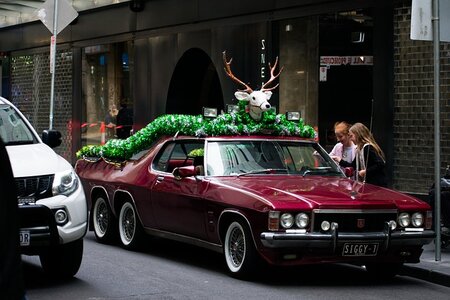
As hunters, we can better gain public support when we consider how non-hunters perceive our actions and when we show respect for their views.
Strapping a Deer on the Roof of a Car
When strapping a deer directly to the roof of a car with no rack or special supports, be sure and use flat woven tie-down or lashing straps that aren’t too thick, like for whitewater rafting. They only need to secure a couple hundred pounds max.
Bungee cords alone are too risky and you’ll almost surely lose your deer while driving down the road.
Rope could do the trick. Though, at best it will be hard to close your door and at worst you could bend your door’s window frame.
Use at least two straps to secure the deer to the roof. Three is better.
Loop each strap completely around the deer so that it tightens around it. Loop one around the neck or in the notch between the front legs and the chest, and another between the abdomen and the hind legs.
Do NOT simply throw the strap over top of the deer as it could easily slide one way or the other and fall off.
You will want to run the two ends of the straps into the car’s cab so they join in the middle of the interior. Do this by opening your doors, running the straps through, then joining and tightening the straps.
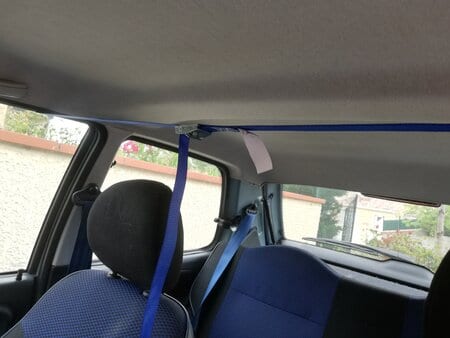
I once carried a bed box spring on a little 2-door hatchback and used this method. I found it worked best to keep the ratchet and buckle part of the tie-down inside the car. This way I could ensure it stayed taut. If it felt loose, I’d give it a quick tug inside to tighten it up while driving.
If you run the straps through the windows, you won’t be able to open the doors!
Tying a Deer on a Roof Rack
If you have a roof rack, whether stock or aftermarket, the process is essentially the same as strapping it directly to the roof. The deer will likely still be in direct contact with the car’s roof.
However, you won’t need to run the straps through the inside of the cab. You can probably even get by with some ⅜” rope or paracord.
Transporting a Deer on a Rooftop Cargo Basket
If using a rooftop cargo basket sounds like a good idea to you, be sure and check the weight capacity. Manufacturers usually claim they support a weight of 150 lbs, which should suffice for most field-dressed deer.
These racks keep the deer (and weight) suspended above the actual car roof. This will help avoid damage like dents or paint scratches. They also have plenty of attachment points for securing the deer, so it really makes it fast and easy.
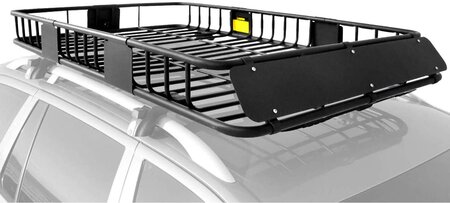
Cargo baskets have been around forever, are simple designs, come in tons of sizes, and can be found relatively inexpensively. They can generally be mounted on any stock roof rack and they last forever.
The downside of rooftop cargo baskets is they can be noisy while driving and they reduce fuel economy. But it’s still cheaper to haul a deer this way than to buy a truck!
The enclosed Thule and Yakima type cargo carriers are often shaped more for aerodynamics than for big game. So it is likely that it will be a challenge fitting the deer in there. Unless you already have one and are willing to risk damaging it with a deer, I’d probably focus on a cargo basket instead.
I don’t recommend one of those rooftop cargo carrier bags for this. They are likely going to trap in heat and moisture and be difficult to fit the deer into. Not to mention their questionable weight capacity and durability.
They’re also more difficult to clean and get the smell out of later. Not great for family vacation time next summer.
How to Tie a Deer To Your Car Trunk
Another viable alternative is to put the deer on top of your trunk. This could keep it cool and be less of a drag than on the roof.
To do this, take two pieces of rope or tie-down straps, about 5-6 ft long each. Open your trunk and tie the ropes to the trunk hatch’s hinge elbows, one on each side, from the inside. Now close the trunk and use the two loose (but secured) ends to tie down the deer.
Tie the deer up at the hip and chest, using its legs as leverage.
This is really only a good idea for smaller deer. If you care about your car, be careful not to overload the rooftop or trunk top. Strapping a bigger deer on a car could leave a permanent dent on the car.
What you for sure do not want to do is put a deer on your hood! Not only are you very-slow-cooking your meat (i.e. spoiling it), but you’re creating a huge safety hazard.
Check your vehicle manual. Consult your local laws. Proceed at your own risk!
Haul a Deer Behind Your Car with a Hitch Hauler or Trailer
Another option is to haul a deer behind your car with a hitch hauler or a small utility trailer.
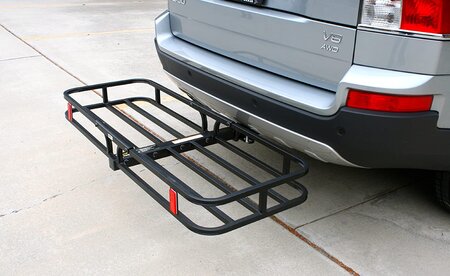
Pros
- Keeps the deer, mess, and smell outside the car
- Keeps ticks found on deer outside the car
- Easy to load and unload
- Self-contained and quick
Cons
- Deer is more exposed to road grime
- Requires a hitch or tow package
- Need to know how to tow a trailer
- Exhaust will likely blow right on the deer
This is a good option if you’ve got a hitch installed and you’re comfortable hauling a trailer. But I wouldn’t go out and install a hitch and buy a trailer just to get a deer home.
The hitch hauler would be my preference over a trailer. I hate burning more fuel to tow an empty trailer, which would be the case on the way to the hunt. It’s just inconvenient to have to tow if it’s not necessary.
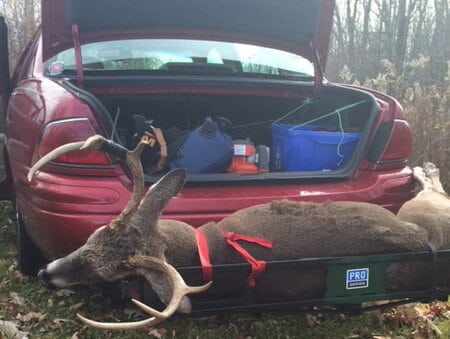
This option is not recommended in rainy or snowy weather. Slush and road grime will likely get onto your kill and spoil your meat. And car exhaust isn’t exactly my idea of smoked venison.
Even in good weather, you likely still need to wrap up your deer in a sheet or tarp to keep it clean and protected en route.
Quarter a Deer for Transport
The last option to get your deer home in a car is to quarter it in the field. Then you can transport it home in containers.
Before you consider this seriously, check your state hunting regulations to see if it is legal to transport a deer in this way. You likely need to keep evidence of sex naturally attached at a minimum (like in my home state of Idaho). But there may be other restrictions as well.
If a game warden pulls you over or you need to stop at a check station, keep things above board. Transport your game right.
It does the hunting community no favors when well-meaning hunters use poacher tactics, even if by accident. Know the rules and follow them.
If this does look like a good option for you, first make sure you know how to properly quarter a deer.
Be sure and take portable containers that both fit in your car and can hold a whole quartered deer.
Use a Cooler to Transport a Quartered Deer
While plastic totes could do the job for a short journey, a solid cooler or two is even better. That way you can pick up some ice at a gas station on your way home to keep the meat cool.
To hold a quartered deer you will need a cooler with a minimum of 65 quarts of capacity. The optimal size cooler would be over 100 quarts. This leaves plenty of room for a bigger deer, quartered with bone in, and some ice.
Something like an RTIC rotomolded cooler would be ideal and you’ll never need to buy another cooler again. The RTIC 110 QT Hard Cooler is a favorite and it’s probably the best for deer transport as well.
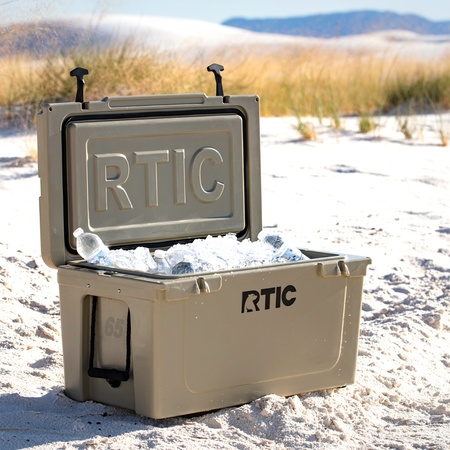
There are some cheap collapsible coolers and tote bag style coolers now that are a good size and could do the trick. You would need a few of them.
The downside is I find them more difficult to keep clean and sanitized. They don’t keep cold for very long (less than a day) and they will wear out quickly.
Longer coolers would be wise as a hind quarter or the spine can be quite long on a deer and it would be nice to not have to do as much work in the field when the meat is as slick as snot.
Whatever you choose, measure the dimensions of your trunk or cargo area first to make sure you can fit what you get.
No matter what you drive, you can bring a deer home. Where there’s a wheel, there’s a way to get your deer home!
Related: Thinking About a Car for Hunting? (Consider This First)

